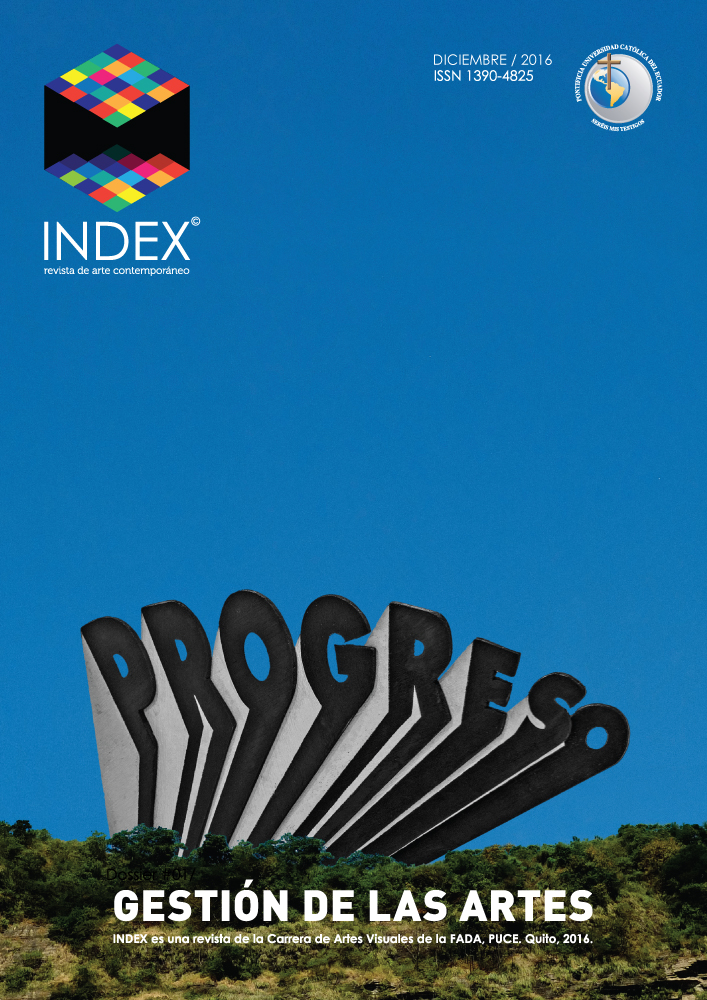RESTOS DIGITALES, EL FANTASMA EN EL CYBERESPACIO arte des-corporal y espiritualidad tecnológica
Contenido principal del artículo
Resumen
El presente artículo aborda la noción de rastros digitales para explorar el miedo a la muerte y los deseos de trascendencia que depositamos en las nuevas tecnologías. Miraremos ejemplos de prácticas artísticas con aproximaciones divergentes a la relación cuerpo-tecnología: ya sea como extensión del ser corpóreo o como descorporalización del ser. Centrándonos en la obra Marilyn, de Philippe Parreno, identificaremos el fantasma y los elementos de la representación espectral, para indagar en los deseos que generan las memorias y huellas en el cyberespacio.
Palabras Clave: espectro, cuerpo-tecnología, corporalidad, descorporalidad, arte y tecnología, cyborg, redes sociales, trascendencia.
Descargas
Detalles del artículo
Index, revista de arte contemporáneo maneja sus derechos bajo licencia Creative Commons Reconocimiento-NoComercial 4.0. En ese sentido los envíos quedan sujetos a la decisión del autor.
Citas
Ajana, B. (2010). Recombinant identities: biometrics and narrative bioethics. Bioethical Inquiry, 7, 237-258.
Baudrillard, J. (1983), Simulacra and Simulations. New York: Sémiotext(e).
Becker, E. (1997), The denial of death. New York: The Free Press.
Becker, E. (1975), Escape from evil. New York: The Free Press.
Berghaus, G. (2005), Avant-garde performance: live events and electronic technologies. New York: Palgrave Macmillan.
Bolter, J. D., & Grusin, R. (2000), Remediation: Understanding New Media. New York: The MIT Press.
Buck, L. (2012). The uncanny world of Philippe Parreno. The Art Newspaper. Recuperado 8 de abril de 2014 de http://www.theartnewspaper.com/articles/The-uncannyworld-of-Philippe-Parreno/26518.
Cavarero, A. (2000), Relating narratives:Storytelling and selfhood. London and New York: Routledge.
Clark, A. (2003), Natural-born cyborgs: minds, technologies, and the future of human intelligence. Oxford; New York: Oxford University Press.
Deleuze, G. y Guattari, F. (1987), A Thousand Plateaus: Capitalism and Schizophrenia. Minneapolis: University of Minnesota Press.
Derrida, J. (1994), Specters of Marx. New York: Routledge.
Dubois, P. (1986), El acto fotográfico. De la Representación a la Recepción. Barcelona: Paidós.
Florian, V. y Mikulincer, M. (1992). The impact of death-risk experiences and religiosity on the fear of personal death: The case of Isrealisoldiers in Lebanon. Omega: Journal of Deathand Dying, 26 (2), 101-111.
Fontcuberta, J. (1997), El beso de Judas: fotografía y verdad. Barcelona: G. Gili.
Grosz, E. (1994), Volatile Bodies: Toward a Corporeal Feminism. Sydney: Allen and Unwin.
Haraway, D. (1991). A cyber manifesto, Sicence, technology, and Socialist-feminism in the late twentieth century. En Simans, cyborgs and woman: the reinvention of nature (pp. 149- 181). New York: Routledge.
Hardie-Bick, J. (2012). Transcendence, symbolic immorality and evil. Hum Stud. 35,415"“428.
Hayles, K. (2001). The condition of virtuality. En P. Lunenfeld (Ed.), The digital dialectic: new essays on new media (pp. 68-87). Cambridge,Mass.: MIT Press.
Horn, R. (1997). Finger Gloves 1972. Tate. Recuperado de http://www.tate.org.uk/art/artworks/horn-finger-gloves-t07845.
Liping, W. (2008). Transcendence or immanence? Lévinas, Bergson, and Chinese thought. Journal of Chinese Philosophy. 189"“104.
Lupton, D. (1995). The embodied computer/ user. Body and Society, 1, 97-112.
Merleau-Ponty, M. (1962). Phenomenology of Perception. London: Routledge & Kegan PaulLtd.,
Peim, N. (2005). Spectral Bodies: Derrida and the philosophy of the photoraph as historical document. Journal of Philosophy or Education,39(1), 67-84.
Raymond, L. M. L. (2008). Modernity, morality and re-enchantment: the death taboo revisited. Sociology, 42(4), 745-759.
Richardson, I., & Harper, C. (2002).Corporeal virtuality: The impossibility of afleshless ontology. Virtual/Informational/Digital.Recuperado 8 de abril de 2014 de http://wwwmcc.murdoch.edu.au/ReadingRoom/
VID/corporeal.html.
Robins, K. (1995). Cyberspace and the world we live in. Body and Society, 1, 135-154.
Van Dijck, J. (2013). "˜You have one identity"™:performing the self on Facebook and LinkedIn. Media, Culture & Society. 35 (2), 199"“215.
Van Loon, J. (2007). Media technology: Critical perspectives. Maidenhead: McGraw-Hill Education.

